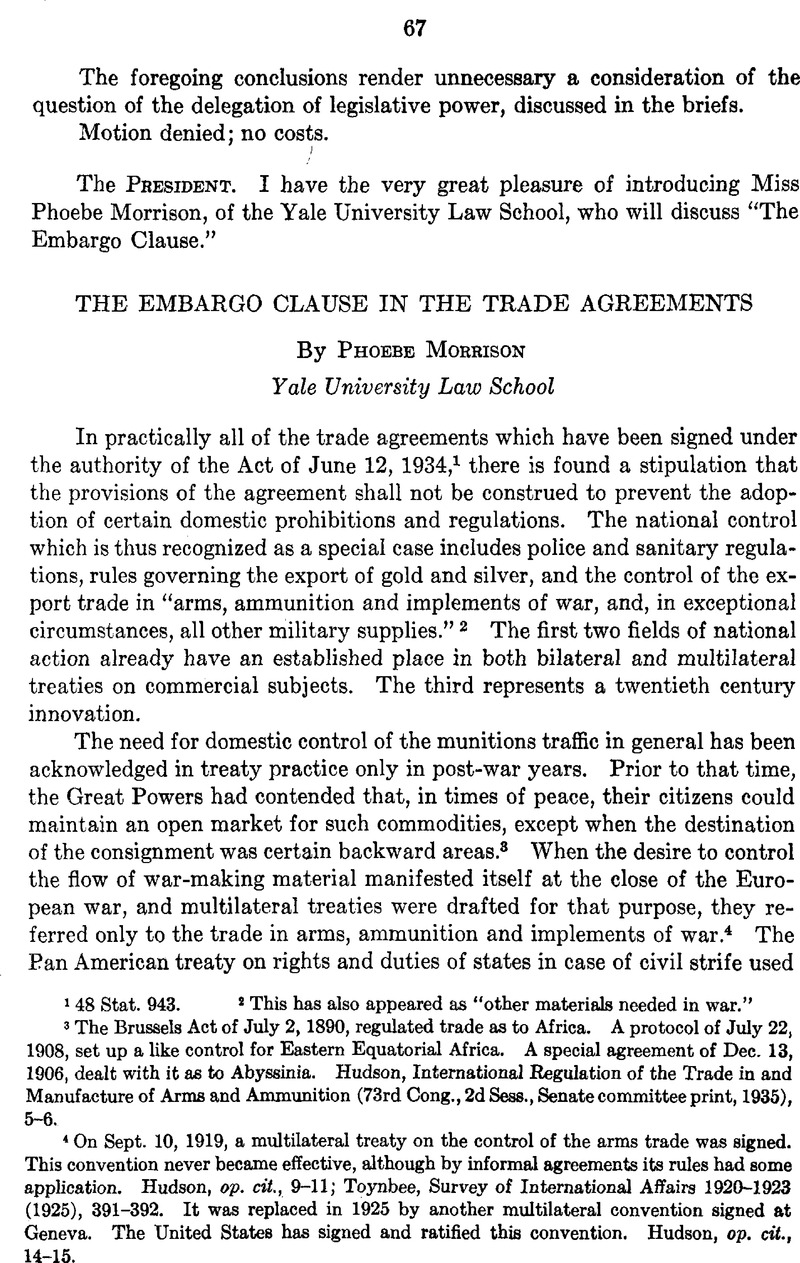No CrossRef data available.
Article contents
The Embargo Clause in the Trade Agreements
Published online by Cambridge University Press: 27 February 2017
Abstract

- Type
- Second Session
- Information
- Copyright
- Copyright © American Society of International Law 1937
References
1 48 Stat. 943.
2 This has also appeared as “other materials needed in war.”
3 The Brussels Act of July 2,1890, regulated trade as to Africa. A protocol of July 22, 1908, set up a like control for Eastern Equatorial Africa. A special agreement of Dec. 13, 1906, dealt with it as to Abyssinia. Hudson, International Regulation of the Trade in and Manufacture of Arms and Ammunition (73rd Cong., 2d Sess., Senate committee print, 1935), 5-6.
4 On Sept. 10, 1919, a multilateral treaty on the control of the arms trade was signed. This convention never became effective, although by informal agreements its rules had some application. Hudson, op. cit., 9-11; Toynbee, Survey of International Affairs 1920-1923 (1925), 391-392. It was replaced in 1925 by another multilateral convention signed at Geneva. The United States has signed and ratified this convention. Hudson, op. cit., 14-15.
5 Havana Convention on Civil Strife, Treaty Series No. 814, Art. 1 (3).
6 Ratification notified Oct. 23, 1929, Treaty Information Bulletin, Oct., 1929, 23-24 Google Scholar.
7 Press Releases, IX, 18 (notified June 29, 1933).
8 Art. 10, para. 2(c), British Treaty Series, 1925, No. 45.
9 See, for example, the treaty with the Serb-Croat-Slovene Kingdom, Art. 9, para. 2(c), British Treaty Series, 1928, No. 6.
10 See, for example, the commercial treaty of Feb. 28, 1928, between France and Belgium, Art. 12, para. 2 (3), 72 League of Nations Treaty Series 61, 71: that of July 2, 1928, between France and Czechoslovakia, Art. 5, para. 2 (3), 99 League of Nations Treaty Series, 107, 111.
11 In the Joint Resolution of March 14, 1912, 37 Stat. 630, and that of Jan. 31, 1922, 42 Stat. 361, the phrase is “arms and munitions of war.” In the Act of Aug. 31, 1935, 49 Stat. 1081, the phrase was changed to “arms, ammunition and implements of war.” The same expression is found in the neutrality legislation recently before Congress.
12 See the opinion of the Attorney General of March 25, 1912, 29 Op. 375-379; that of May 20, 1912, id., 414; that of April 20, 1912, id., 394; that of Nov. 18, 1912, id., 570; that of Jan. 8, 1913, 30 Op. 9; that of Aug. 11, 1913, id., 213; that of Oct. 6, 1913, id., 227; and that of March 3, 1920, 32 Op. 132-135.
13 Laws and Regulations Administered by the Secretary of State Governing the International Traffic in Arms, Ammunition and Implements of War (Washington, 1936), passim.
14 1931 British Stat. Rules, 252. This control was begun during the World War and has continued ever since, according to Mr. Runciman, 266 Pari. Deb. (5th ser.) 1757 (June 7, 1932).
15 See, for example, the list for which export license is required, 132 Board of Trade Journal, 526-527 (Apr. 5, 1934)Google Scholar; see also Report of the Royal Commission on the Private Manufacture of and Trading in Arms (1935-1936) (London, 1936), 69 Google Scholar; and also the testimony of W. B. Brown, of the Board of Trade on Nov. 27,1935, Minutes of Evidence Taken by the Royal Commission on the Private Manufacture of and Trading in Arms (London, 1935), 325 Google Scholar.
16 Procès-Verbaux of the Committees of the First Assembly, No. 2 (Nov. 25, 1920), 14 Google Scholar.
17 2 League of Nations Official Journal, 1, 143, 145.
18 3 League of Nations Official Journal, 697-698.
19 5 League of Nations Official Journal, 989.
20 Nollet, , Une Expérience de désarmament: Cinq Am de Contrôle militaire en Allemagne (Paris, 1932), 168-170 Google Scholar; Roques, Le Contrôle militaire interallié (Paris, 1927), 69-72 Google Scholar.
21 1920 Reichsgesetzblatt, 2167-2169
22 1921 Reichsgesetzblatt, 767-769
23 Report of the Work of the Reparations Commission from 1920 to 1922 (London, 1923), 49 Google Scholar.
24 15 League of Nations Official Journal, 766.
25 Hudson, op. cit., 57-61.
26 Hemming, Report of the International Committee for the Application Regarding Non-intervention in Spain (Spain No. 2 (1936), Cmd. 5300), 54-55 Google Scholar.
27 Idem, 56.
28 Idem, 57.
29 Miller, Drafting of the Covenant (N. Y., 1928), I, 286-289 Google Scholar.
30 5 League of Nations Official Journal, 1607.
31 Malloy, , Treaties, I,969. See Klotz, , “Neutrality Laws and Exceptions to Commercial Treaties,” Proceedings American Society of International Law, 1936, 138-146 Google Scholar, and discussion, id., 146-162.
32 See Bonn, “How Sanctions Failed” (1937), 15 Foreign Affairs, 350, 354-357 Google Scholar.
33 See Weilk, , “League sanctions and foreign trade restrictions in Italy” (1937), 27 American Economic Review, 97-107 Google Scholar.
34 See Noel-Baker, , The Private Manufacture of Armaments (N. Y., 1937)Google Scholar, Ch. 5 (The evasion of international obligations for disarmament and the prevention of aggression).
35 See especially, Culbertson, , “Raw materials and foodstuffs in the commercial policies of nations,” 112 Ann. Acad. Pol. Sc., 1, 38-44 (March, 1924)Google Scholar; Feis, “After tariffs, embargoes” (1931), 9 Foreign Affairs, 398-399 Google Scholar; Glenn, , “War without guns” (1932), 8 Virginia Quarterly Rev., 388-408 Google Scholar.




